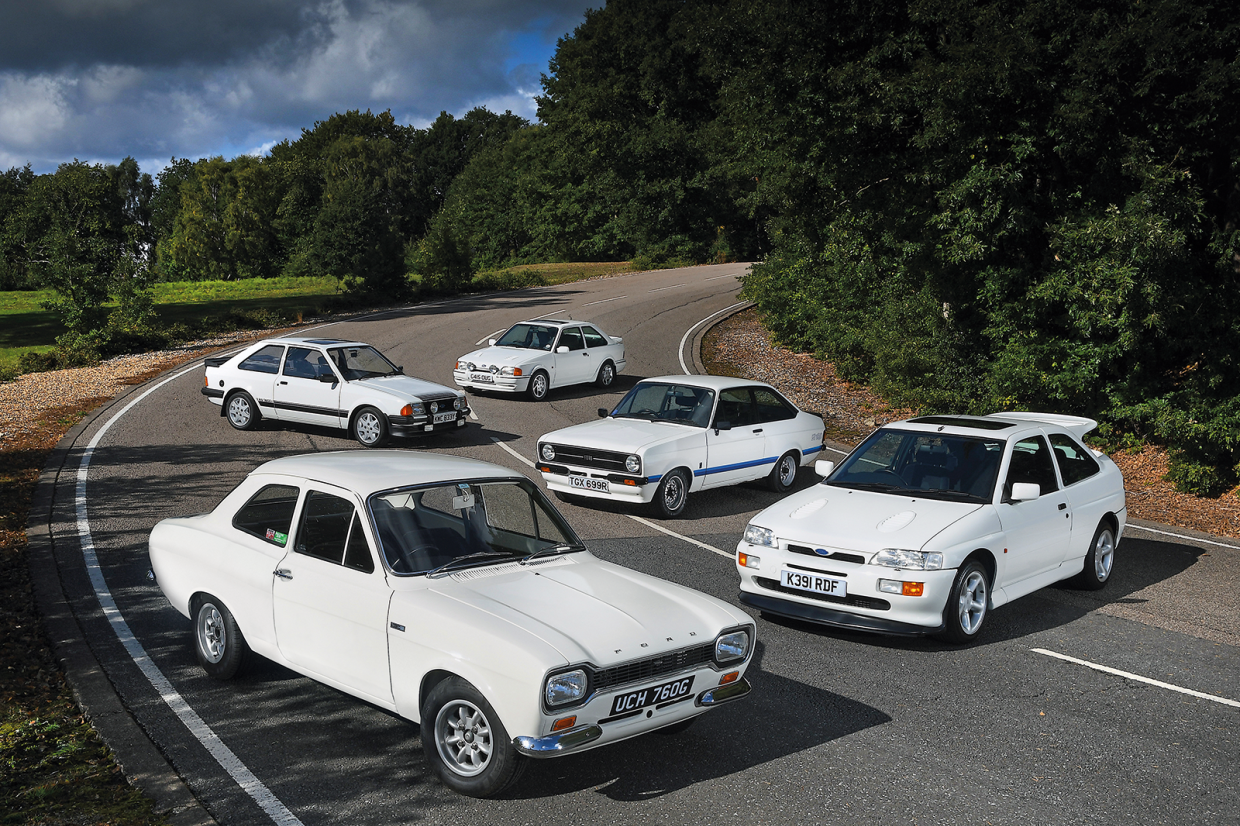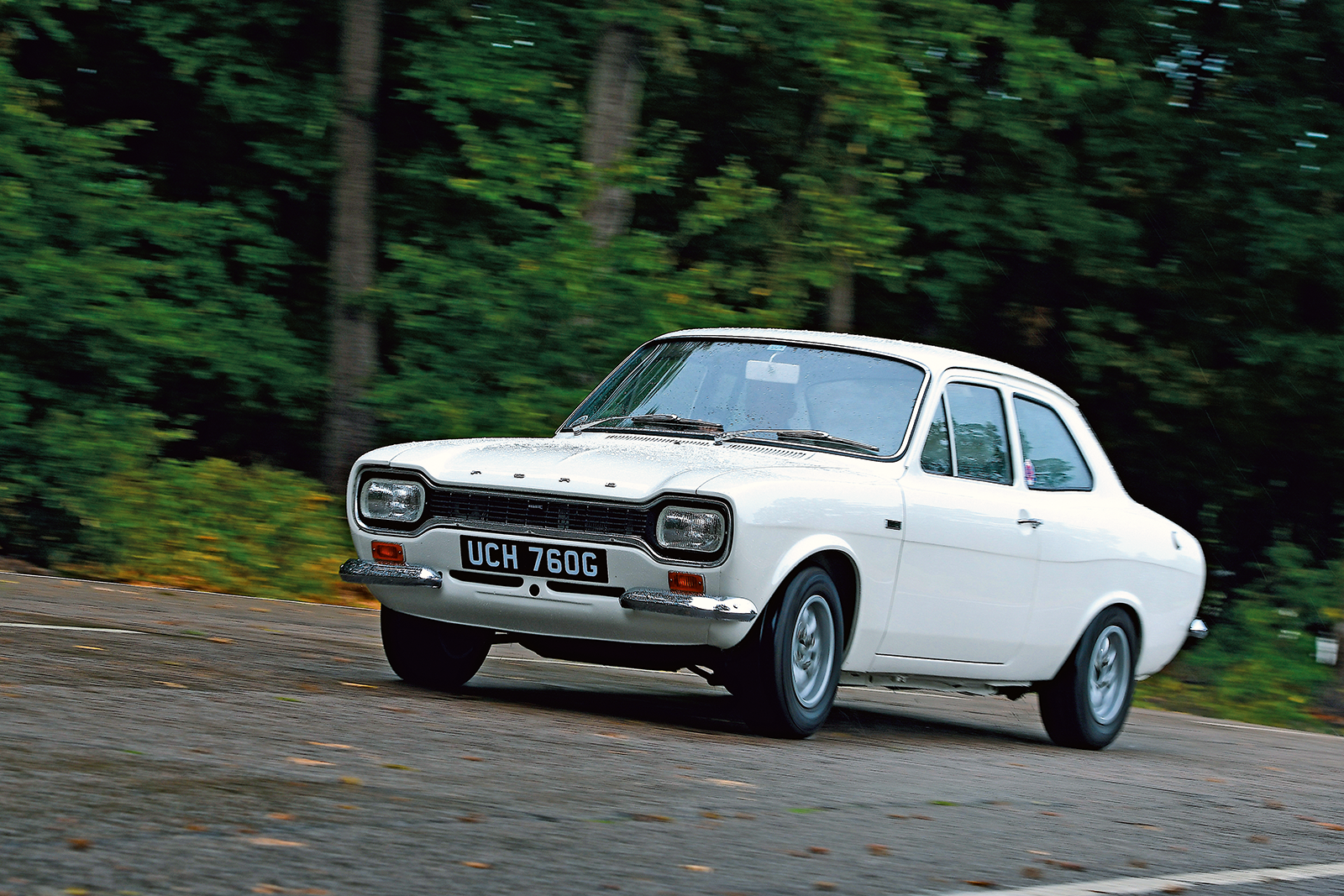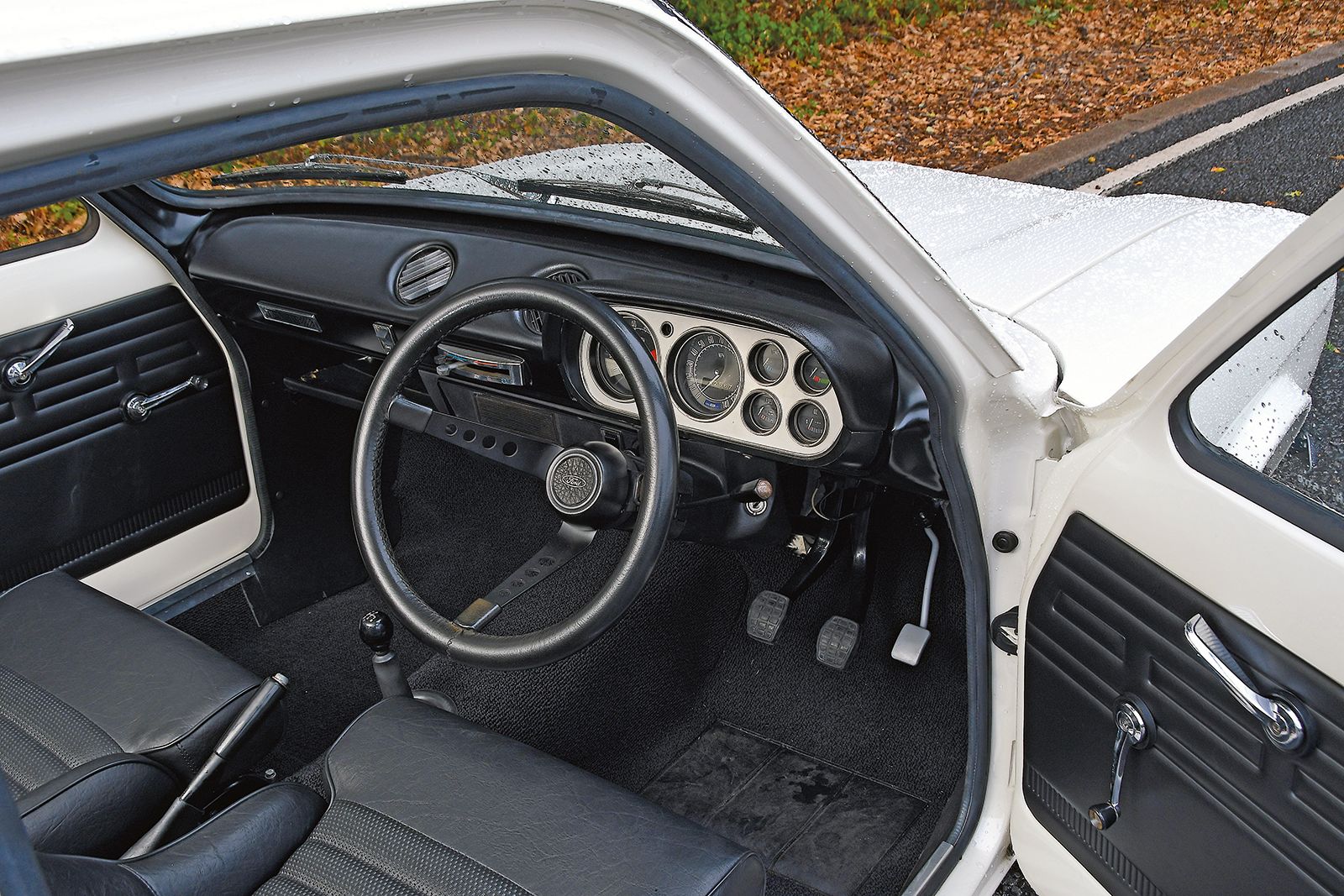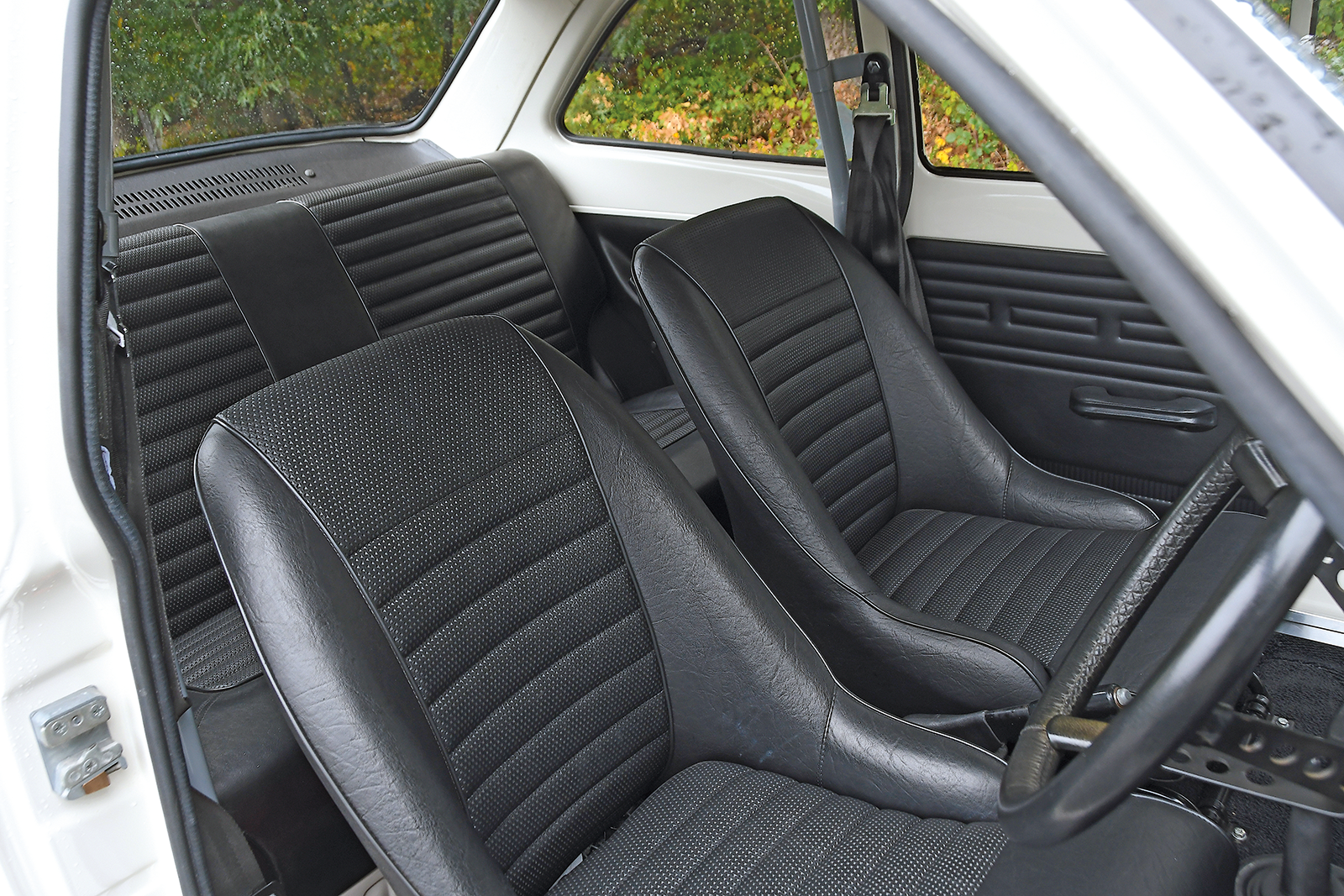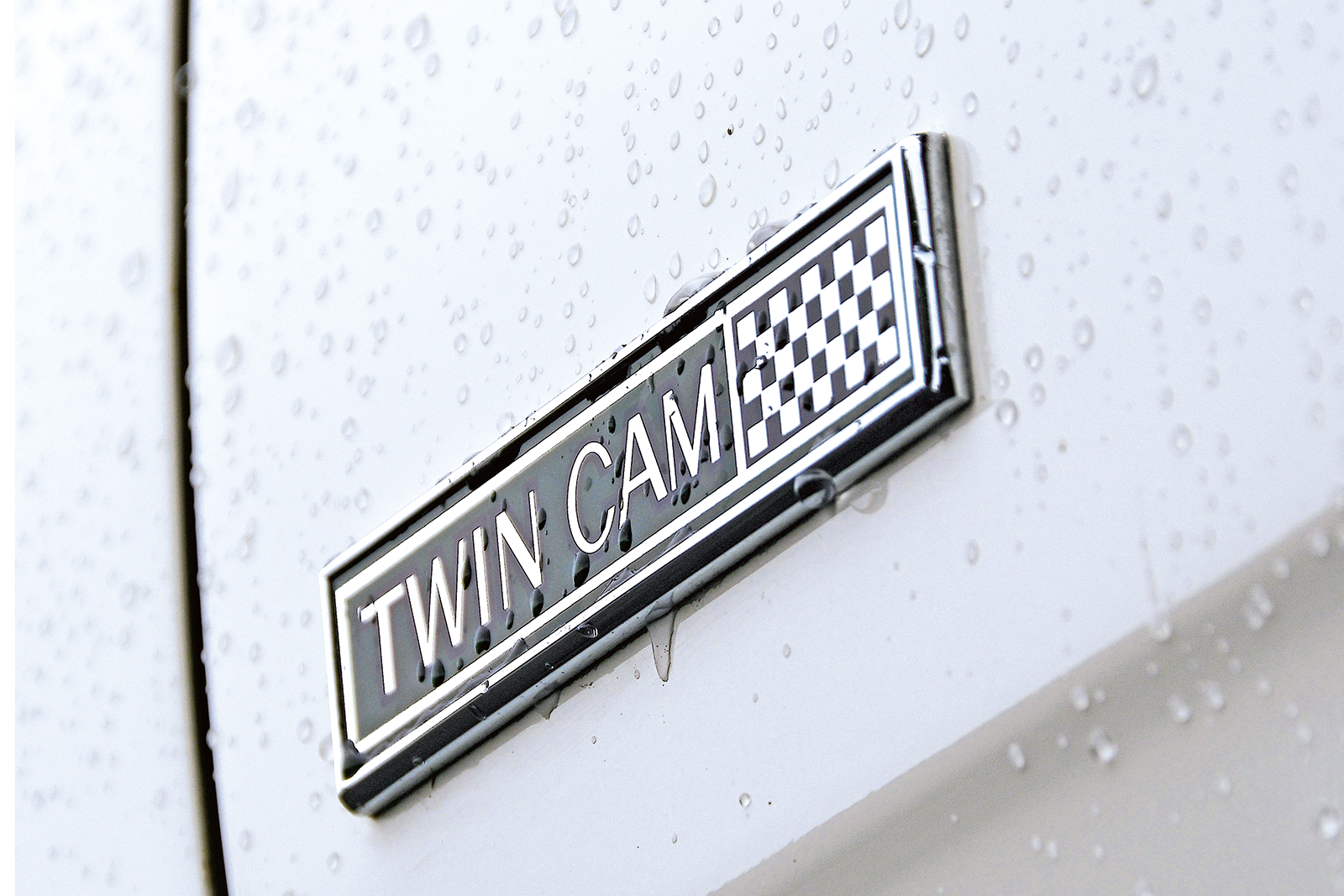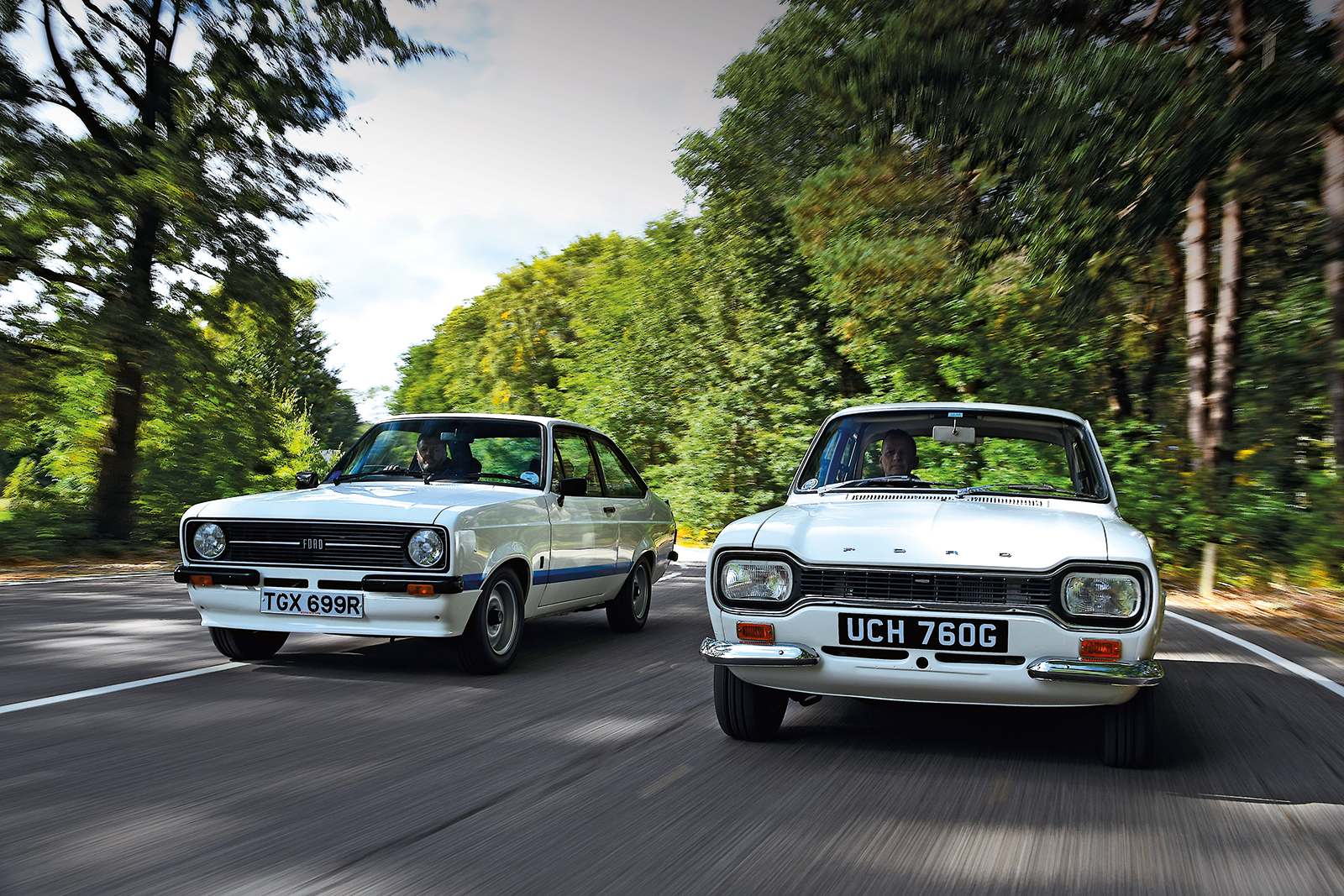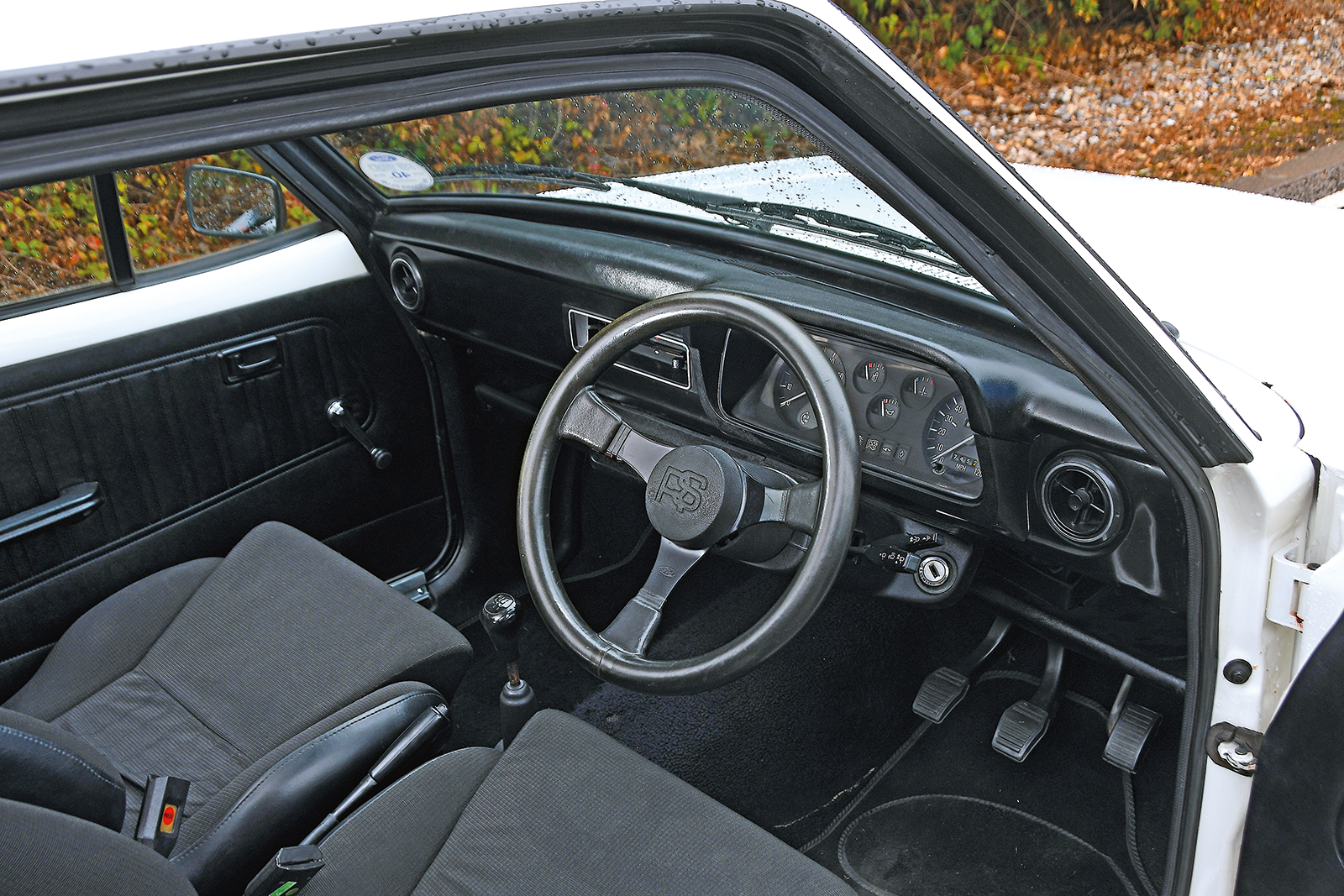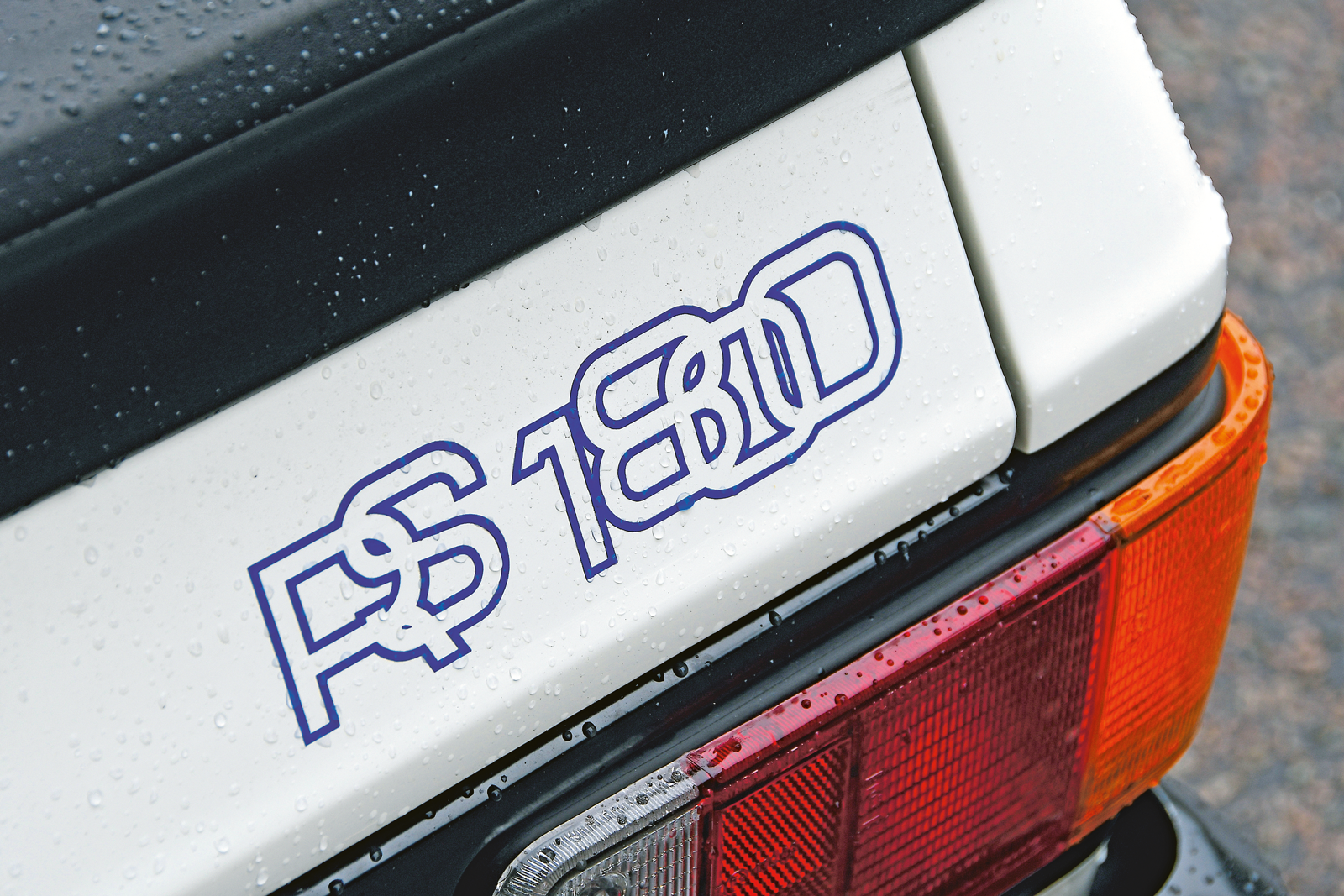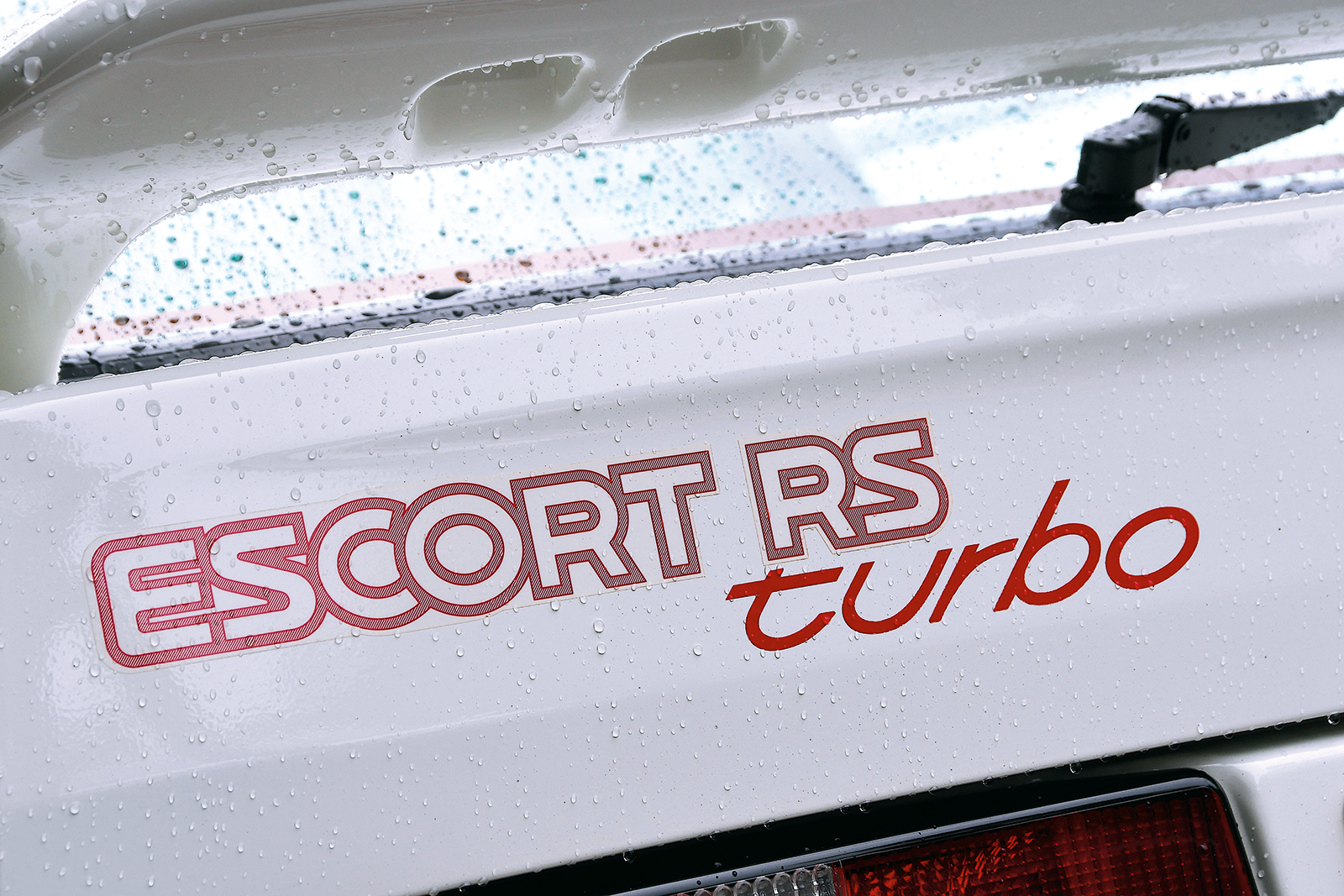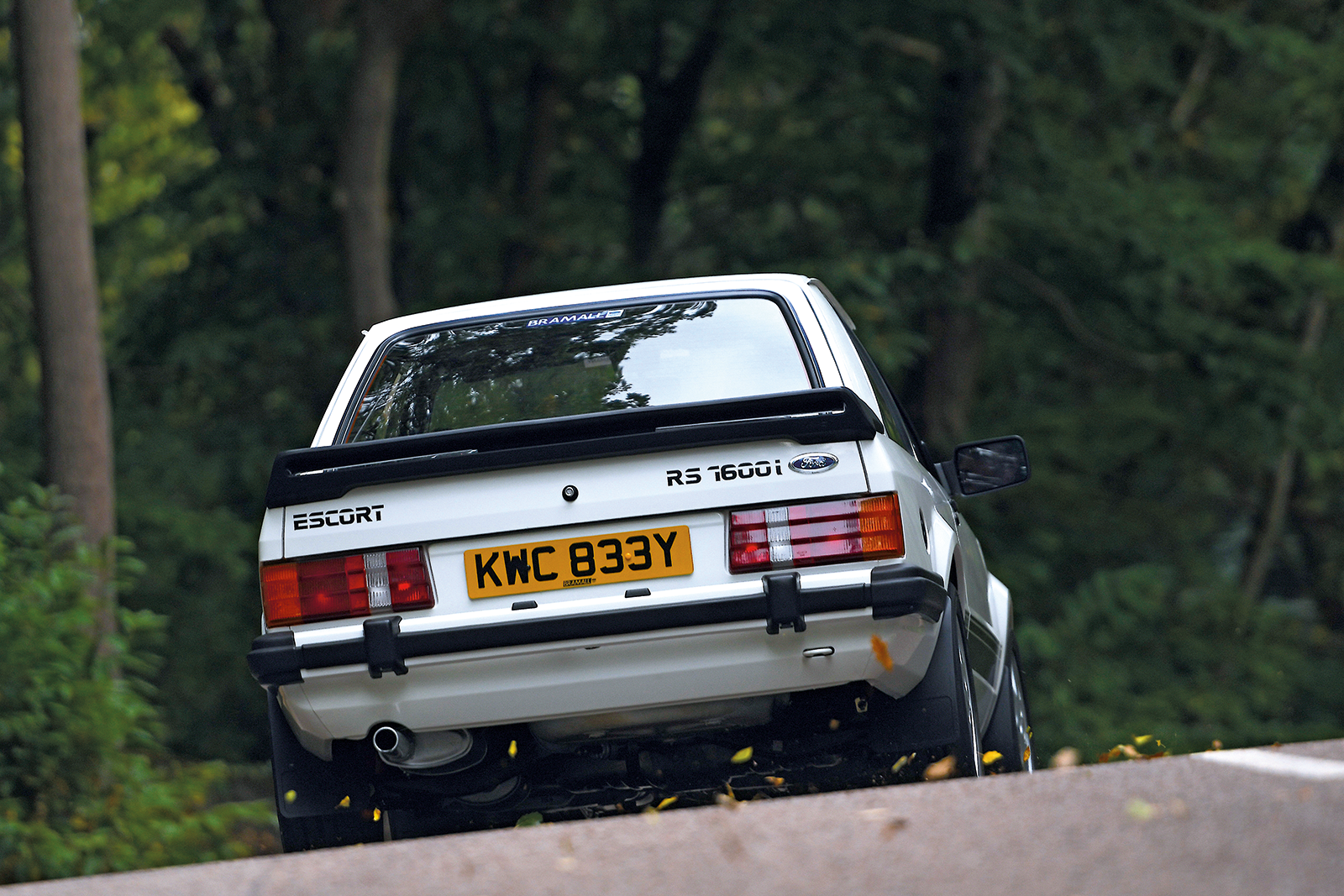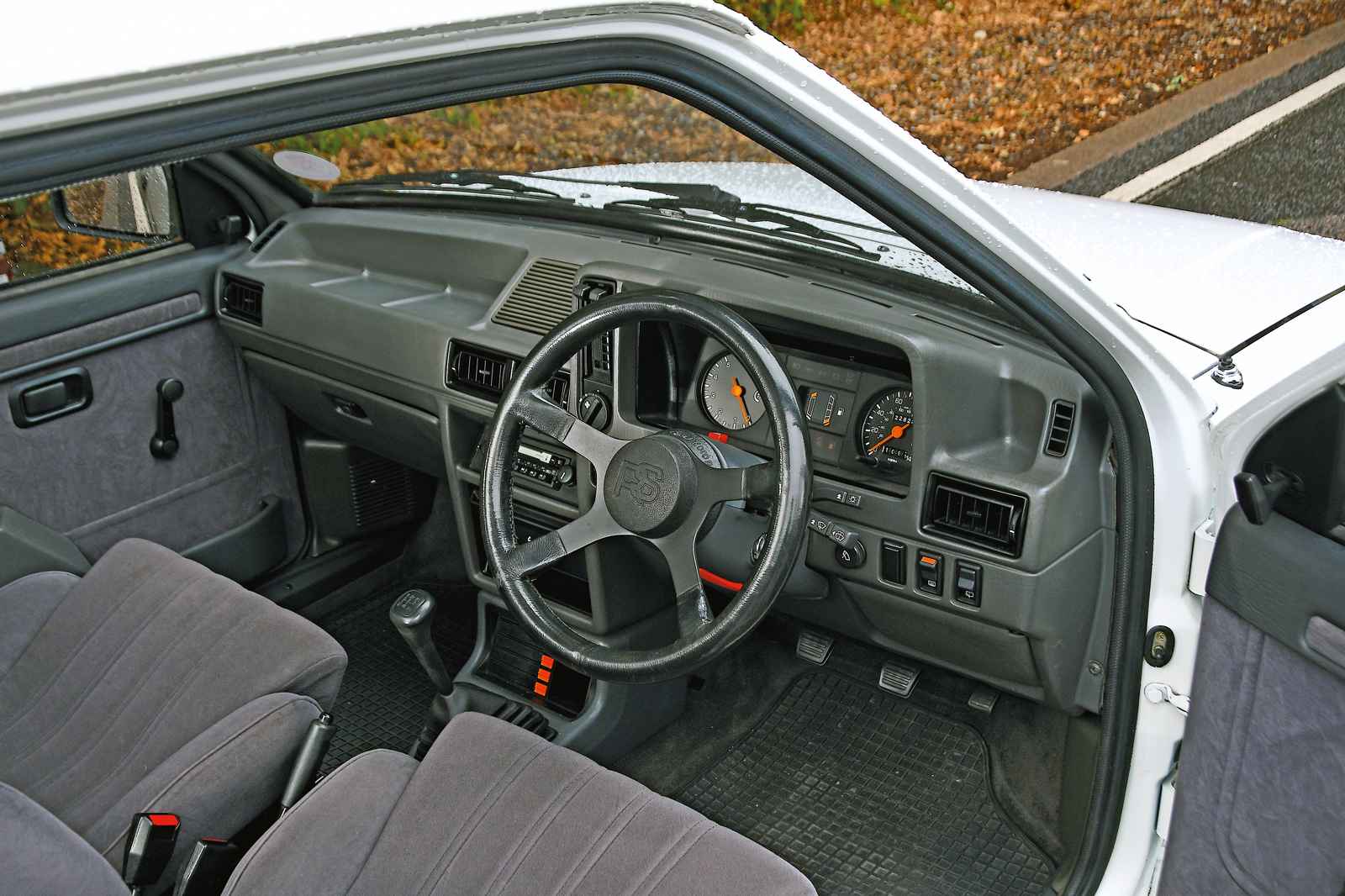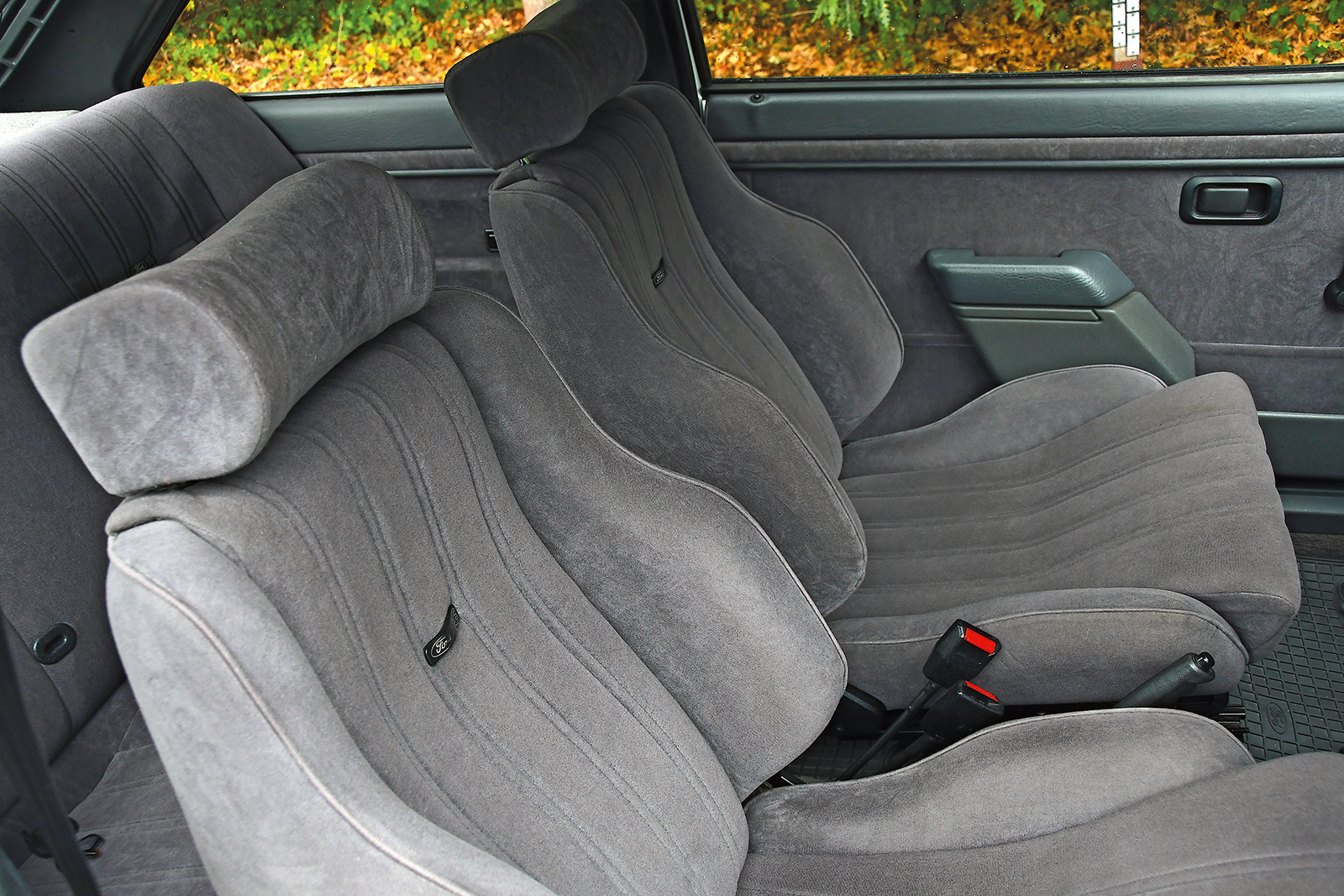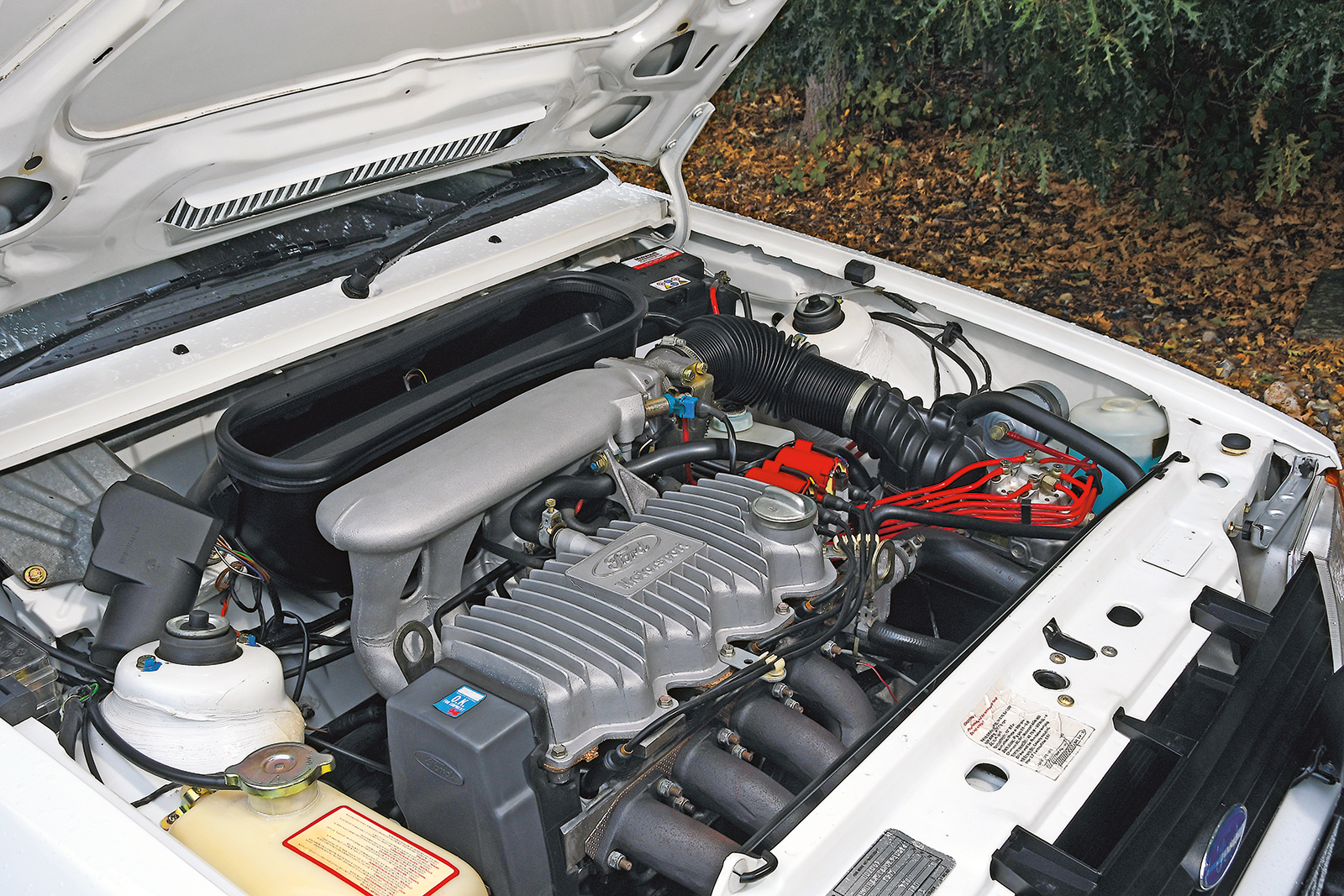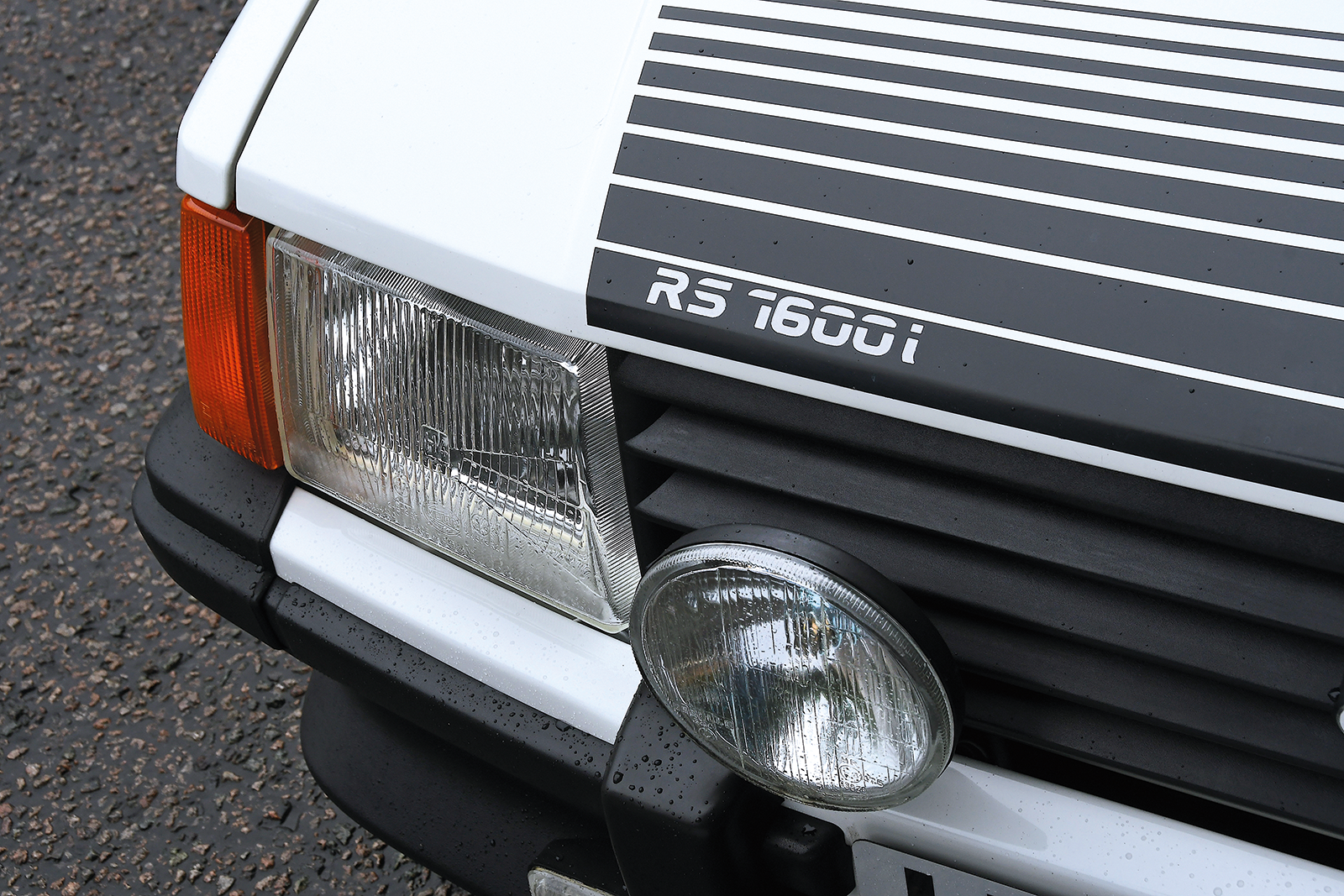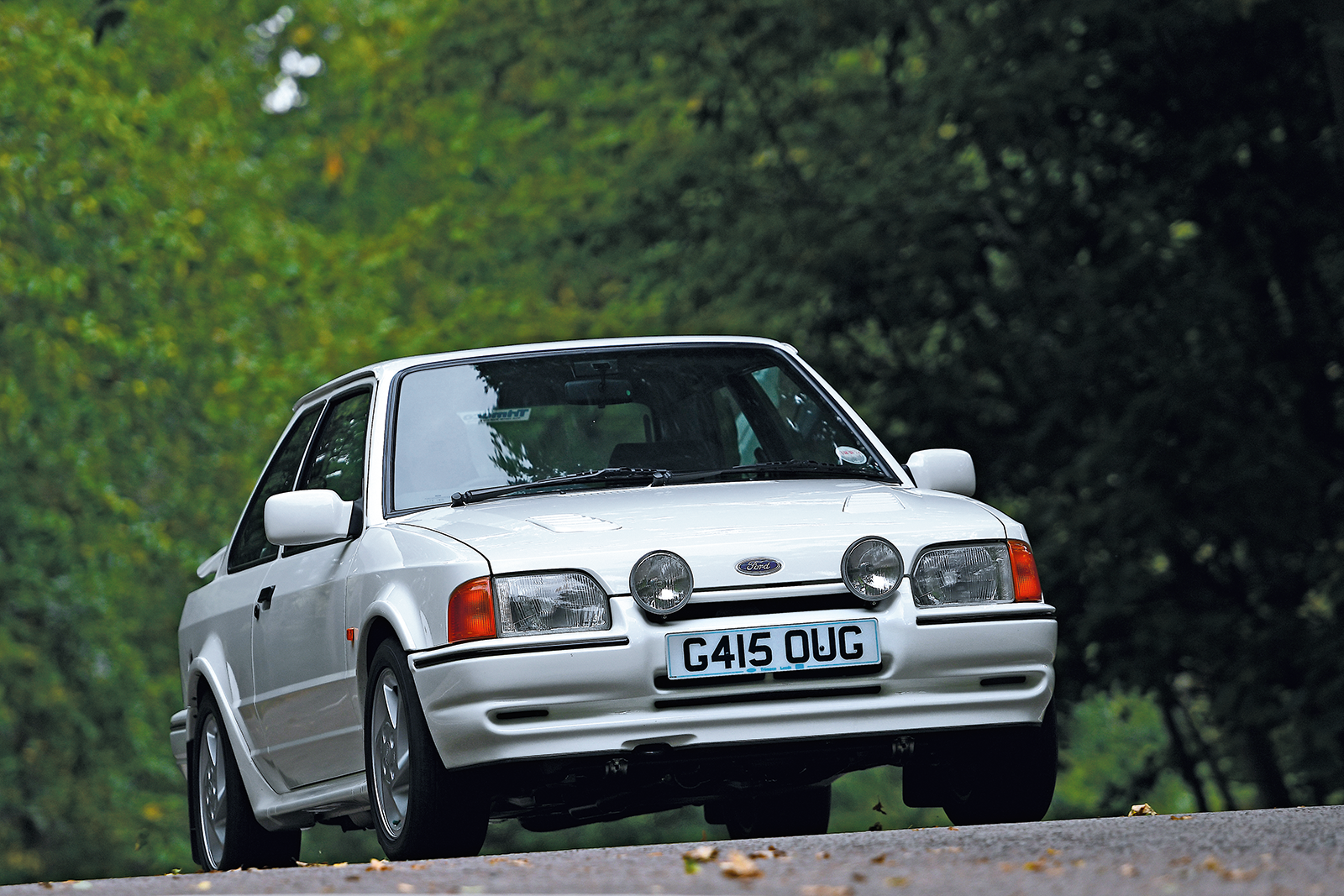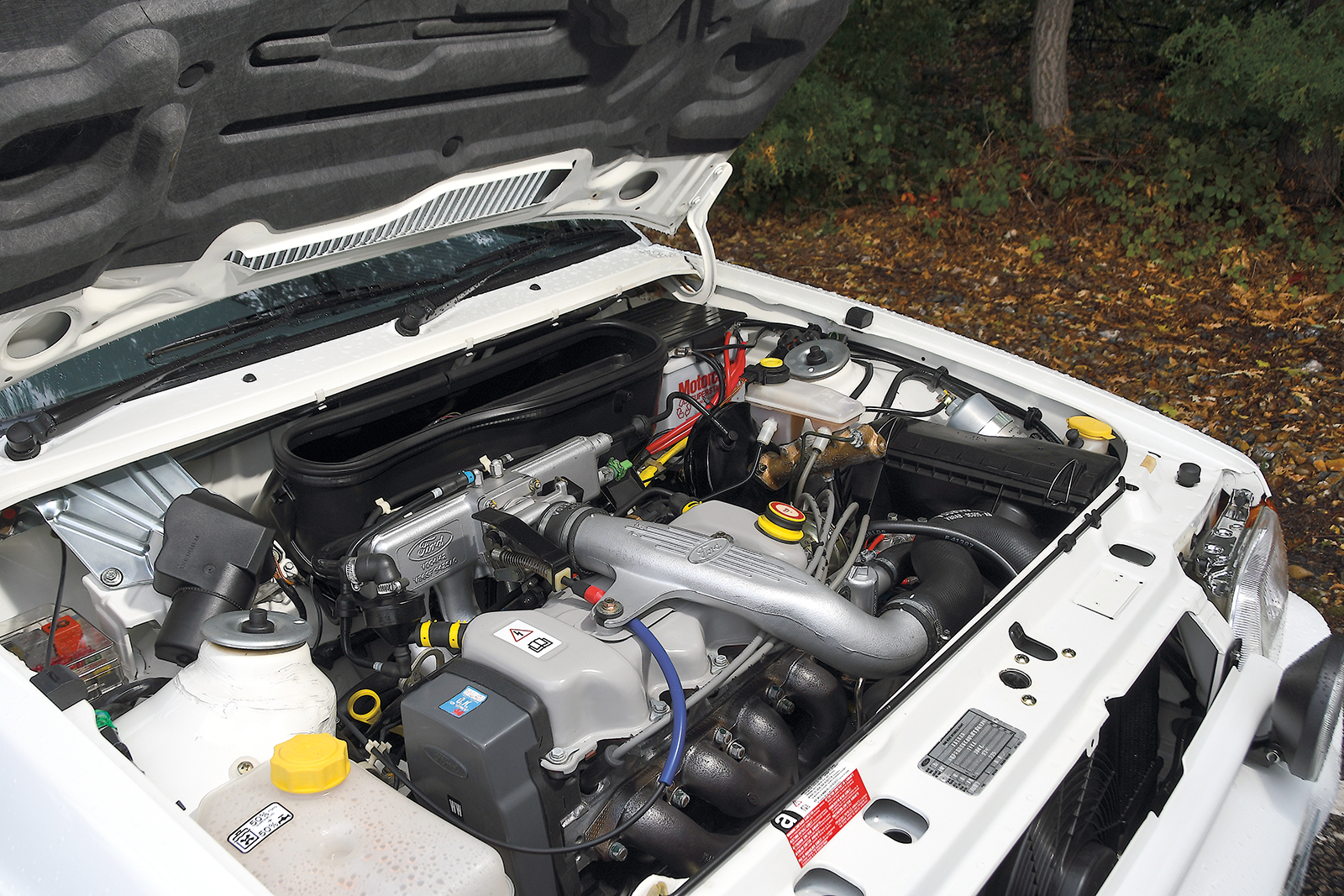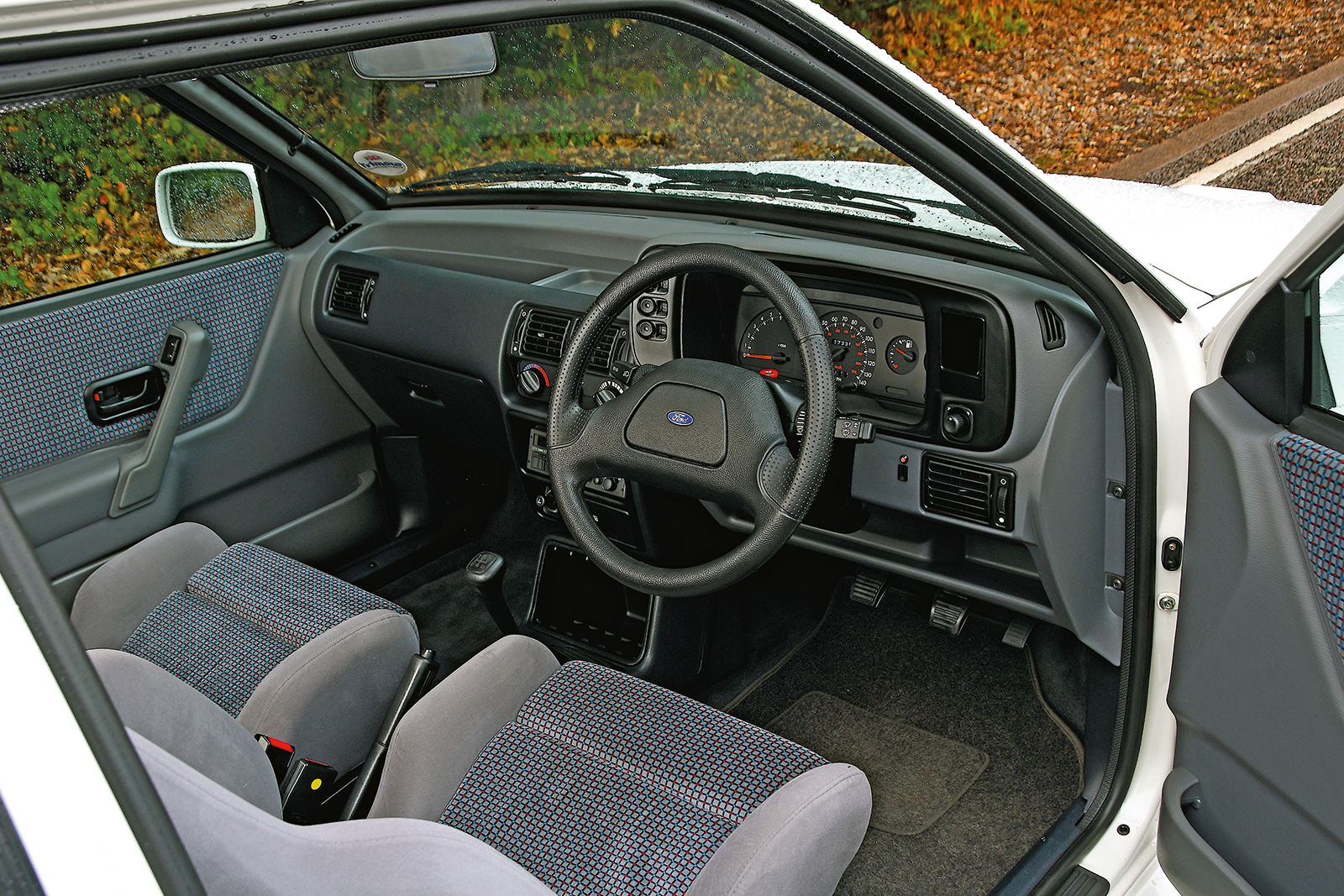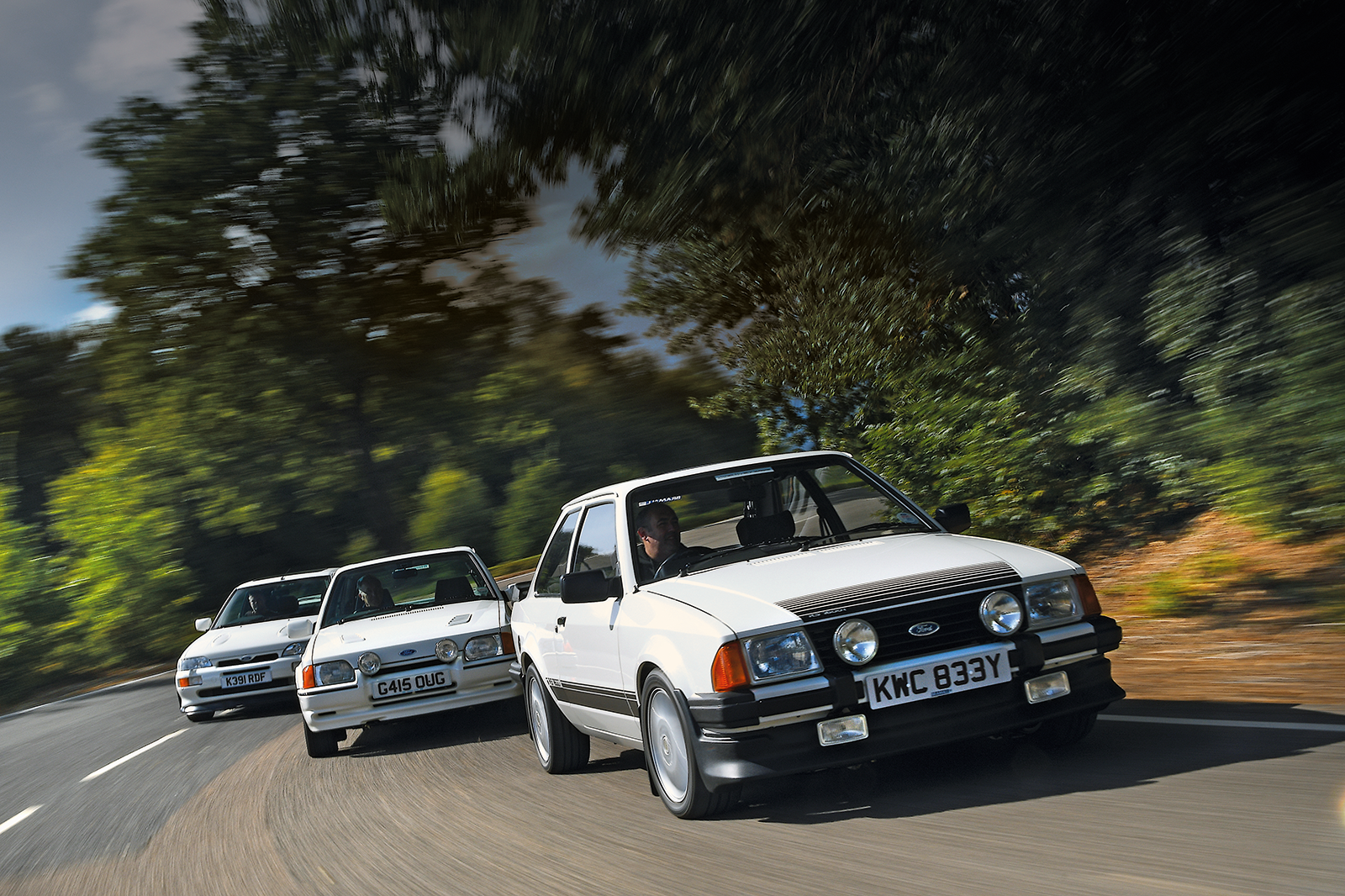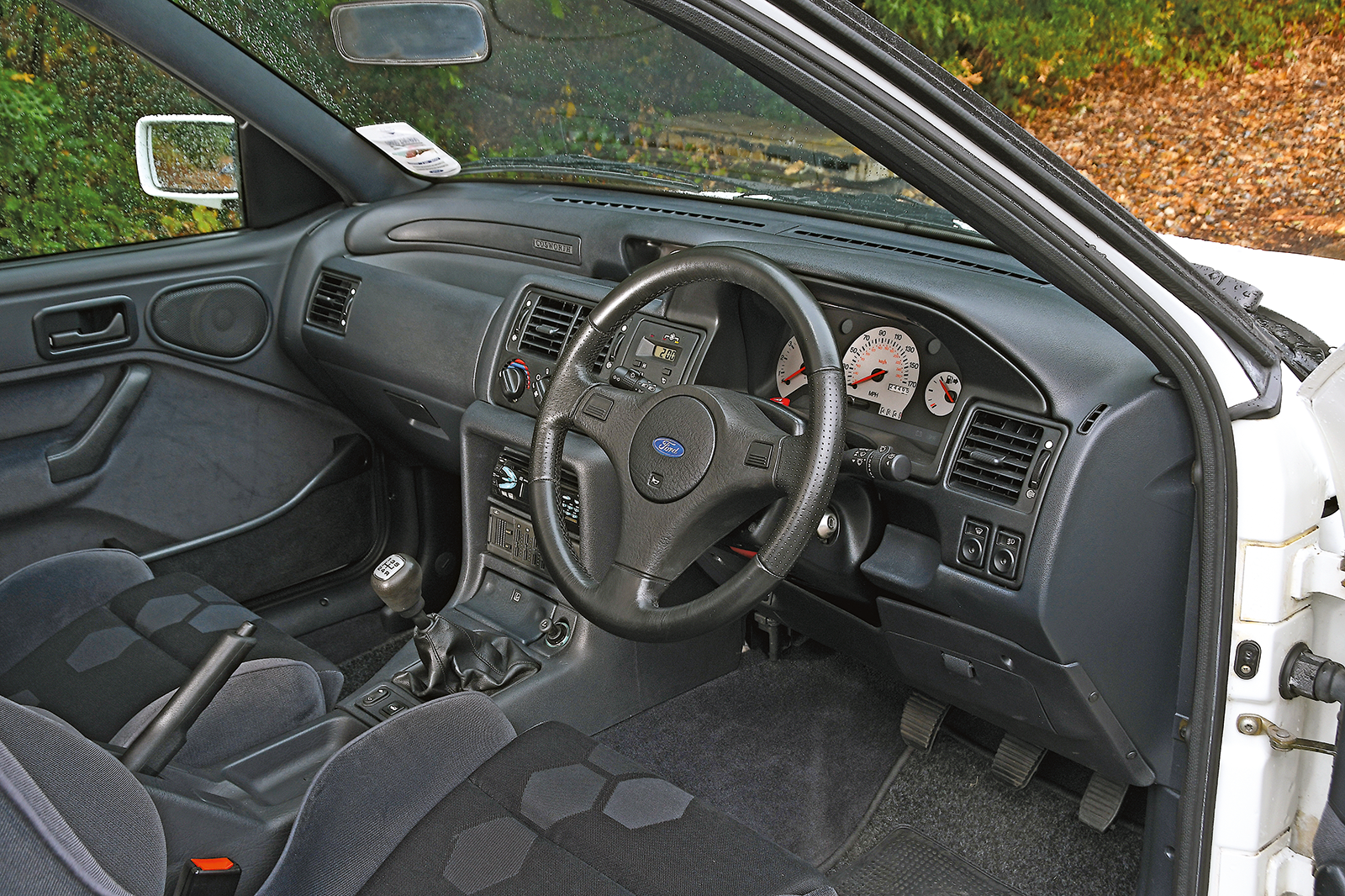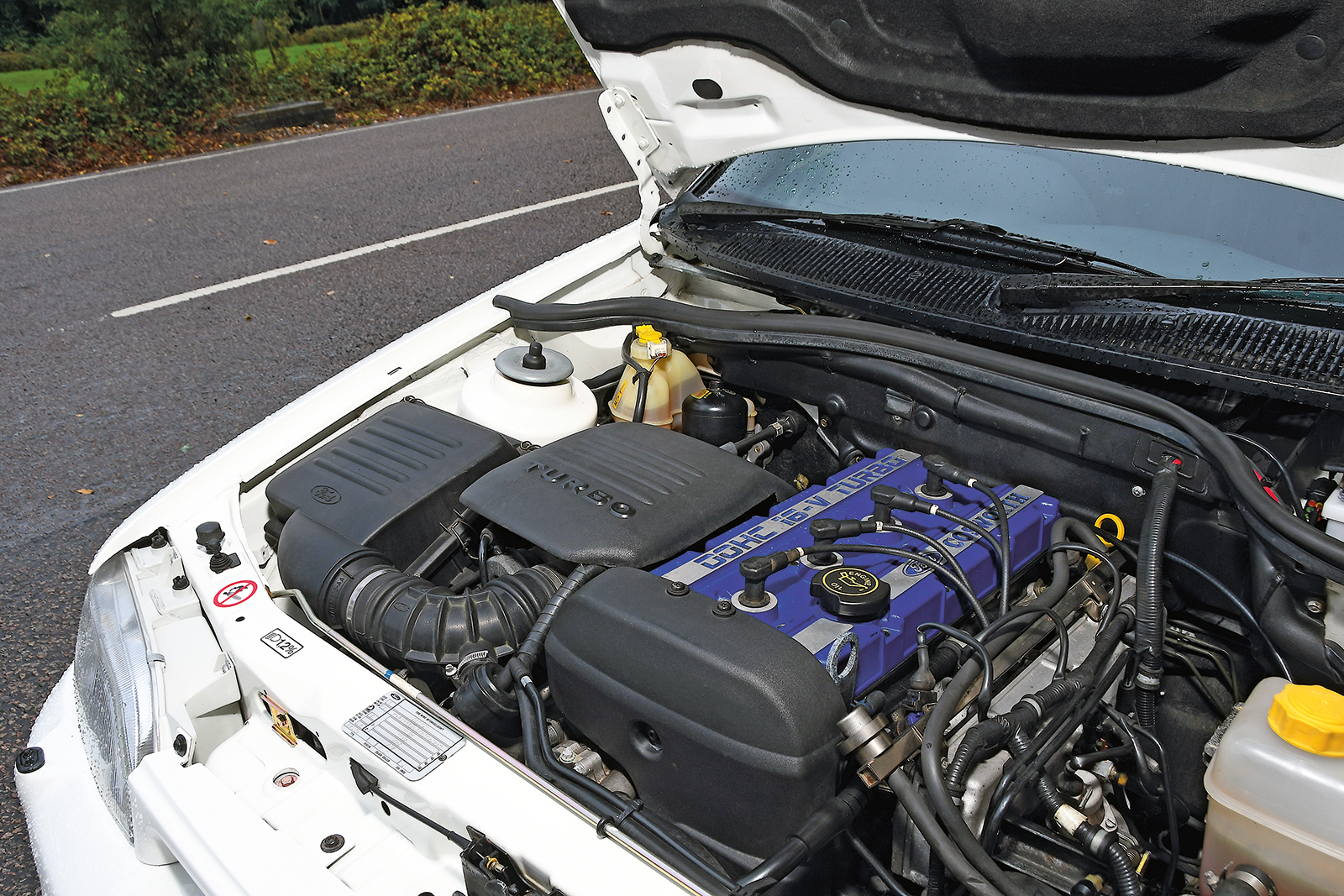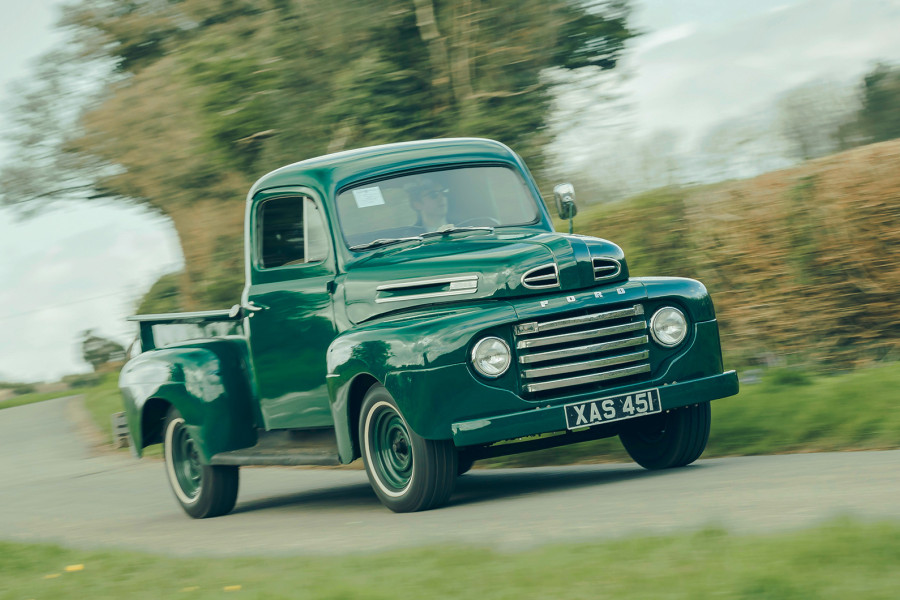A year after Ford retired from international rallying the final Mk2 Escort rolled off the production line, with 1980 marking the end of a special period for both the model and for motorsport.
But by that stage Rallye Sport was a household name, and it wasn’t long before it found a home in the new Mk3 with the 1981 RS 1600i.
Built for homologation, the model smashed Ford’s initial 5000 sales target: 8659 cars had left showrooms by the time production ended in July 1983.
Yet despite good results in Group A on track in the hands of Richard Longman and Alan Curnow, plus Malcolm Wilson and Louise Aitken-Walker on the stage, it wasn’t quite the success Ford had hoped for.
The interior of this 21,000-mile Mk3 is pristine
Compared with the exotic twin-cam units of the Mk1 and Mk2, the RS 1600i is lacking somewhat in the engine department, fitted with Ford’s drab and clattery 1597cc CVH ‘four’.
Though slightly uninspiring on paper, the model boasted a number of interesting features designed for use in competition.
Among them was a unique AFT twin-coil ignition system to complement the Bosch K-Jetronic fuel injection, while internally the engine was fitted with solid tappets and a hotter camshaft.
In race spec, that provided enough strength to rev far beyond the roadgoing car’s 6500rpm limit.
Putting the RS 1600i’s modest 115bhp to the road was a suspension system that varied from any other production Escort, with two longitudinally mounted supporting arms with a separate anti-roll bar to the front.
As well as allowing the castor angle to be adjusted – vital for its motorsport applications – the set-up helped to reduce torque steer, a new problem that engineers had to overcome in only the company’s second attempt at a front-wheel-drive car after the Fiesta of 1976.
The RS 1600i’s CVH got solid tappets
In competition trim the RS 1600i produced in the region of 160bhp, but in standard guise it doesn’t quite live up to the RS name: compared with the lively Mk1 and ballistic Mk2, the later car feels quite pedestrian with lukewarm acceleration, though with surprisingly tidy handling.
Where this particular Escort excels is its condition, with Ball’s example feeling showroom-fresh in every way.
It’s as if the car has been meticulously assembled from new-old stock parts, removed from their wax paper one by one and pieced together to create a perfect, as-new example.
But it’s better than that: it’s a car that has never been apart, and as such feels precisely as it should with taut suspension and a complete lack of squeaks or clonks.
Decals and front spotlights on this Mk3 RS 1600i
A close rival in terms of timewarp appeal is Ball’s Series 2 RS turbo, which with just 17,340 miles on the clock is surely one of the best Mk4s in the country.
“Prior to my ownership it was a multiple concours winner and was used extensively on the show circuit, but that’s not really my thing.
“It’s got all-original paint and all-original panels; it’s never been restored, just extensively detailed over the years.”
The casual observer may struggle to tell the two ’80s cars apart, and it makes more sense to talk about the later car in terms of a facelift of the Mk3 – and specifically of the first RS turbo that was launched in 1984.
The design tweaks from the Mk3 to this Mk4 were subtle
A true homologation special, the original RS turbo was aimed squarely at clubmen competing in Group A and N.
Forced induction provided the quickest and most cost-effective means of maintaining the front-drive Escort’s competitiveness, and again it was the humble1597cc CVH – fitted with solid tappets, Bosch injection and twin-coil distributorless ignition – that served as the basis.
Allied to that was a Garrett T3 turbocharger that raised power to 132bhp, while a special viscous limited-slip differential – the first of its type fitted to a front-wheel-drive car – improved traction.
By the time the Series 2 arrived in 1986 the RS turbo’s manners had been improved, making it more of a road car than a competition weapon.
Fettled rather than redesigned, it gained a turbocharger that was water- rather than air-cooled, while a number of small refinements were made to everything from gearing and engine management to the clutch and brakes, including fitting mechanical ABS.
The turbo added spice to the staid CVH
Inside, the Escort lineage is clear to see with an instrument binnacle that harks back to the Mk1 and Mk2 and figure-hugging Recaro seats finished in period light-grey velour.
As in the RS 1600i, it’s hard not to be slightly disappointed by the soundtrack of the gruff CVH, but in the RS turbo it feels perfectly suited to the car’s road-biased character, particularly when the Garrett turbocharger kicks in to provide a welcome burst of mid-range thrust.
If the Series 2 RS turbo was a small step forward, the 1992-on Mk5 Cosworth was a giant leap.
The final true RS to bear the Escort name (the Mk6 RS 2000 made do with just 150bhp) and the last in Ball’s collection, it was also the last in a trio of stunning Cosworth creations preceded by the Sierra and Sapphire.
The idea to combine the Escort ’s compact body with Sierra running gear came about in 1988 and, following the success of an early test mule, the job of creating a production-ready car was given to Ford Special Vehicle Engineering at Dunton.
No longer a three-spoke wheel in this cabin
The final design differed so much from the conventional Escort that production had to be outsourced to Karmann in Germany, where a shortened Sierra floorpan was mated to the Sapphire 4x4’s revised engine and running gear – no mean feat given the changes involved.
The Escort went from being front-wheel-drive with a transverse engine to a longitudinal engine layout with four-wheel drive.
More than 400 unique components had to be designed and even the bodywork was radically altered: despite the clear familial resemblance, only the cooking model’s roof, doors and pillars remained unmodified.
The most eye-grabbing feature was surely the enormous split-wing rear spoiler, which robbed 4mph from the car’s top speed but, combined with the adjustable front splitter, helped to make the RS Cosworth the first mass-produced car to generate both front and rear aerodynamic downforce.
Generational changes are most pronounced in the RS Cosworth, with the additional cooling vents one of the most obvious changes from Mk3/4
Like its forebears, the Cosworth was destined for top-flight rallying from the off, and the first 2500 cars built had homologation in mind.
Early examples such as Ball’s were fitted with Weber-Marelli fuelling and ignition plus an enormous Garrett T03/T04B turbocharger, with some even sporting a dummy water-injection kit to get the parts approved for competition.
Though less tractable than the later ‘small turbo’ cars that came on stream in ’95, the big turbo is eminently more tuneable and holds more cachet in Ford circles.
Turn the key and you soon realise why.
A more focused interior in the Cosworth
On the road the Cossie feels light-years ahead of the other cars in the collection, both in terms of modernity and performance.
It could easily pass for a typical mid-’90s repmobile at low speed, but that all changes when you plant the accelerator to the floor.
It’s an old-school turbo with plenty of lag and plenty of grunt, and after a split-second delay the telltale ‘wooosh’ presses your head against the headrest and streaks beads of rain off the windscreen.
As in most of Ball’s cars, it’s a rare treat to experience a Cosworth as its manufacturer intended.
“I haven’t really done anything to it,” he explains.“It’s covered 24,000 miles now, and it was at 19,000 when I bought it. As the value has increased I’ve used it less and less. It’s totally standard; totally original.”
The two-litre car can hit 137mph
For many enthusiasts, choosing their favourite car is like picking their favourite child.
But not all Escorts are created equal, and while it’s satisfying to see one of each generation lined up for our test, the third and fourth iterations – the RS 1600i and RS turbo – inevitably bring up the rear in terms of styling, performance and overall driver involvement.
Some way ahead of them is the Cosworth, which, despite being the most modern of our set, captured the imagination of younger enthusiasts in much the same way as the legends of the past.
For many the Mk2 RS 1800 is the pick of the litter, often hailed as the Holy Grail both for its rarity and scintillating performance, and it speaks volumes that Ball uses his car so regularly despite its astronomical value.
Ultimately, the almost inconceivable increase in popularity and asking prices of old Escorts points to one thing: enthusiasts reliving their misspent youth.
And in that, Gary Ball is no different: “My first Escort was a Mk1, a Mexico that I got in 1986. After that I bought my first Twin Cam, and I went on to have four in total. I’ve had this one for 20 years – it’s taken that long to get it done. It’s the car that means the most to me.”
Images: John Bradshaw
Factfiles
Ford Escort Twin Cam
- Sold/number built 1968-’71/1263
- Engine dohc 1558cc ‘four’, twin Webers; 109bhp @ 6000rpm; 107Ib ft @ 4500rpm
- Transmission four-speed manual, RWD
- Weight 1730lb (785kg)
- Mpg 23.4
- 0-60mph 9.9 secs
- Top speed 113mph
- Price new £1123
- Price now £40-70,000*
Ford Escort RS 1800
- Sold/number built 1975-’77/109
- Engine dohc 1835cc ‘four’, twin Webers; 115bhp @ 6000rpm; 120Ib ft @ 4000rpm
- Transmission four-speed manual, RWD
- Weight 2015lb (914kg)
- Mpg 26.5
- 0-60mph 8.3 secs
- Top speed 111mph
- Price new £2825
- Price now £60-120,000*
Ford Escort RS 1600i
- Sold/number built 1981-’83/8659
- Engine sohc 1597cc ‘four’, fuel injection; 113bhp @ 6000rpm; 109Ib ft @ 5250rpm
- Transmission five-speed manual, FWD
- Weight 2072lb (940kg)
- Mpg 36.7
- 0-60mph 8.7 secs
- Top speed 119mph
- Price new £7024
- Price now £15-40,000*
Ford Escort RS turbo
- Sold/number built 1986-’90/c22,000
- Engine sohc 1597cc ‘four’, Garrett T3 turbocharger; 132bhp @ 5750rpm; 133Ib ft @ 2750rpm
- Transmission five-speed manual, FWD
- Weight 2381lb (1080kg)
- Mpg 36
- 0-60mph 8.3 secs
- Top speed 125mph
- Price new £10,278
- Price now £15-40,000*
Ford Escort RS Cosworth
- Sold/number built 1992-’96/7145
- Engine dohc 1993cc ‘four’, Garrett T03/T04B turbocharger; 224bhp @ 6250rpm; 224Ib ft @ 3500rpm
- Transmission five-speed manual, AWD
- Weight 2811lb (1275kg)
- Mpg 28
- 0-60mph 6.2 secs
- Top speed 137mph
- Price new £20,524
- Price now £45-70,000*
*Prices correct at date of original publication
READ MORE
The man who took the Ford Capri to greatness
How Britain nearly missed Mercedes’ brilliant 230TE
Driving Jochen Rindt’s Alfa Romeo GTA
Greg MacLeman
Greg MacLeman is a contributor to and former Features Editor of Classic & Sports Car, and drives a restored and uprated 1974 Triumph 2500TC
